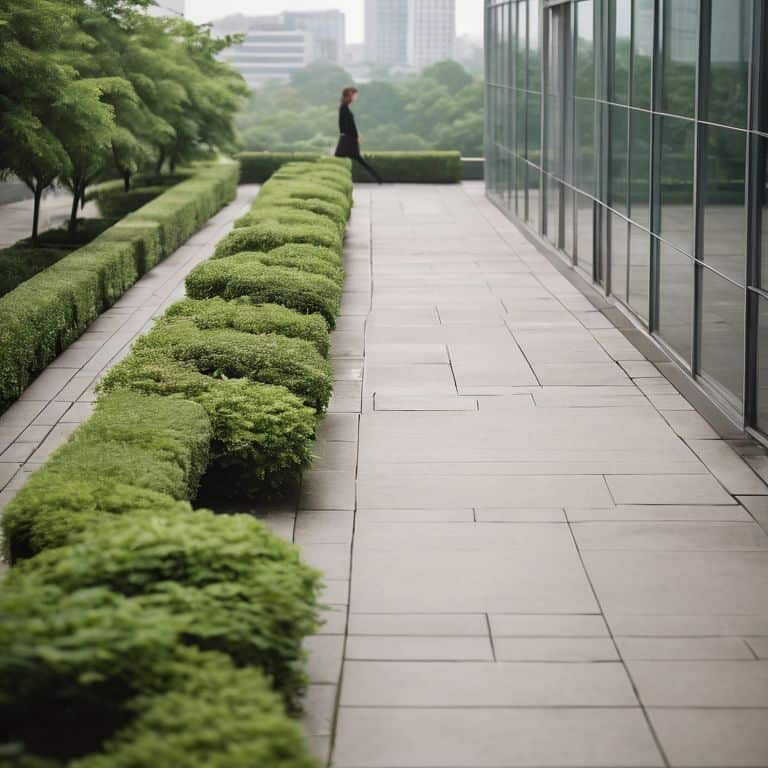Take a deep breath in, and as you exhale, allow your eyes to gently focus on this moment. I still remember my first experience with a 5-minute walking meditation for my work break – it was as if I had stumbled upon a hidden doorway to a peaceful sanctuary amidst the chaos of my corporate job. The common myth that meditation must be done in stillness, with eyes closed, and for an extended period, had initially deterred me. However, I discovered that even in the simplest of actions, like walking, lies the potential for profound mindfulness.
As we embark on this journey together, I promise to guide you through a practical, step-by-step approach to incorporating a 5-minute walking meditation for your work break into your daily routine. You’ll learn how to transform a brief pause in your day into an opportunity to awaken your inner calm and refocus your mind. By the end of this article, you’ll be equipped with the knowledge to effortlessly weave mindfulness into your busiest of schedules, finding serenity in the most unexpected moments, and cultivating a deeper connection with your inner self.
Table of Contents
Guide Overview: What You'll Need

Total Time: 5 minutes
Estimated Cost: free
Difficulty Level: Easy
Tools Required
- Comfortable shoes (or bare feet)
Supplies & Materials
- Quiet outdoor space (or a calm indoor area)
Step-by-Step Instructions
- 1. First, let’s start by finding a quiet and peaceful spot to take our 5-minute walking meditation, perhaps a short stroll around the office building or a nearby park. Take a deep breath in, and as you exhale, allow your eyes to gently focus on the path ahead, letting go of any distractions.
- 2. Next, take a moment to ground yourself by noticing the sensation of your feet touching the ground. Feel the weight and pressure of your body distributed evenly on both feet, and as you breathe in, imagine fresh energy entering through the soles of your feet, nourishing your entire being.
- 3. Now, let’s begin our walking meditation by taking small, deliberate steps. As you take your first step, focus on the sensation of your foot lifting off the ground, the movement of your leg, and the placement of your foot back on the earth. Bring your attention to the sensation of each step, allowing your mind to settle into the present moment.
- 4. As we continue walking, allow your arms to relax by your sides, with a slight gentle swing. Notice the rhythm of your breath and the movement of your body, and try to synchronize them, so that with each step, you’re also taking a breath in or out. This will help you cultivate a sense of inner calm and harmony.
- 5. As you walk, bring your attention to the sensory experiences around you – the sounds of nature, the sensation of the air on your skin, or the sight of the trees or flowers. Allow these sensations to become your anchor, keeping you present and focused on the current moment, rather than getting caught up in thoughts or worries.
- 6. Now, let’s introduce a simple mantra to enhance our walking meditation: “step, breathe, step, breathe.” As you say this mantra to yourself, emphasize the sensation of each step and the corresponding breath, allowing the rhythm to guide you deeper into a state of relaxation and awareness.
- 7. As we approach the end of our 5-minute walking meditation, take a moment to notice how you feel. Notice any changes in your body or mind, such as a sense of calmness or clarity. Take one final, deep breath in, and as you exhale, slowly open your eyes, feeling refreshed, renewed, and ready to return to your day with a sense of inner peace.
Find Calm in Chaos

As we navigate the hustle and bustle of our workdays, it’s easy to get caught up in the chaos. But what if we could find a sense of calm amidst the noise? Mindful movement at work can be a powerful tool in reducing stress and increasing productivity. By incorporating short mindfulness exercises into our daily routine, we can begin to shift our focus away from the constant stream of tasks and towards the present moment.
One of the most effective ways to do this is by utilizing breathing techniques for stress. By taking a few deep breaths, we can calm the nervous system and quiet the mind. This can be especially helpful during a busy workday, when it’s easy to get caught up in feelings of overwhelm. As we practice our walking meditation, remember to focus on the sensation of your feet touching the ground, and the rhythm of your breath.
By incorporating mindful movement into our work break, such as a walking meditation, we can begin to experience the walking meditation benefits for ourselves. This can include reduced stress, increased focus, and a greater sense of overall well-being. As we make our way back to our desks, take a moment to notice how you’re feeling, and remember that quick office stretches can be a great way to loosen up and refocus throughout the day.
5 Minute Walking Meditation for Your Work Break
As we navigate the bustling hallways of our workplace, it’s easy to get caught up in the hustle and bustle. But what if we could find a slice of serenity amidst the chaos? Let’s take a deep breath in, and as we exhale, allow our feet to touch the ground, feeling the weight and connection to the present moment. In just 5 minutes, we can transform our work break into a mindful escape.
By incorporating a short walking meditation into our daily routine, we can awaken our senses and calm our minds. With each step, we invite the freshness of the present moment to unfold, letting go of stress and worries. As we walk, notice the sensation of your feet touching the ground, the rhythm of your breath, and the sights around you. Allow yourself to settle into the tranquility that arises from being fully engaged in the present.
Breathe Easy With Short Mindfulness
As we navigate the hustle and bustle of our daily lives, it’s easy to get caught up in the chaos. But what if I told you that calm is always just a breath away? Take a deep breath in, and as you exhale, imagine any tension or stress leaving your body. In those brief moments, we can find a sense of serenity.
By incorporating short mindfulness exercises into our routine, we can learn to breathe easy, even in the midst of chaos. Try pausing to take three conscious breaths before responding to a stressful email or meeting. This simple act can help calm your mind and bring clarity to your thoughts.
Embracing Serenity: 5 Essential Tips for Your 5-Minute Walking Meditation
- Begin by setting an intention to let go of distractions and focus on your breath and the sensation of your feet touching the ground
- Choose a quiet and peaceful route for your walking meditation, either indoors or outdoors, to minimize external distractions
- Pay attention to your posture, keeping your head held high, shoulders relaxed, and spine straight, allowing you to breathe more effortlessly
- Bring awareness to each step, noticing the lifting and placing of your feet, and the movement of your legs and arms, to cultivate a sense of presence
- End your walking meditation by taking a few deep breaths, noticing how you feel, and carrying that sense of calm and clarity back into your workday
Key Takeaways for a More Mindful You
By incorporating a 5-minute walking meditation into your work break, you can significantly reduce stress and increase your sense of calm and clarity
Remember, the goal of mindfulness isn’t to achieve a specific state, but to gently return to the present moment, again and again, with kindness and curiosity
Whether you’re in a busy office or a quiet outdoor space, taking a few conscious breaths and paying attention to your steps can be a powerful anchor for your mind, helping you stay grounded and focused throughout your day
Mindful Moments at Work
As we walk, may our footsteps quiet the mind, and may our breath be the gentle reminder that serenity is always just a step away, even in the midst of a busy workday.
Elara Keane
Embracing the Calm Within

As we conclude our journey through the 5-minute walking meditation for your work break, remember that the goal is not to achieve a specific state, but to cultivate awareness in each step. We’ve explored the simple yet profound act of paying attention to our breath, our footsteps, and the sensations in our body. By incorporating this practice into your daily routine, you’ll find that it’s possible to find calm in chaos and approach challenges with a clearer, more focused mind. Recall the steps we’ve taken together: from the initial deep breath to the mindful walking, and finally, to the moment of stillness before returning to your tasks.
As you return to your day, I invite you to carry the serenity of the present moment with you. Remember, mindfulness is not a destination; it’s a gentle, continuous process of returning to the breath. May the peace and clarity you’ve glimpsed during our time together stay with you, inspiring you to approach life’s journey with a sense of wonder, compassion, and inner peace. May your path be lit with the soft glow of mindfulness, guiding you home to the calm, serene space within yourself, where love, kindness, and wisdom reside.
Frequently Asked Questions
Can I practice walking meditation in a small office space or do I need to be outdoors?
Take a deep breath in, and as you exhale, imagine any concerns about space dissolving. You can practice walking meditation anywhere, even in a small office space. Simply find a quiet corner, or pace slowly between your desk and a wall, focusing on the sensation of each step, bringing mindfulness to your movement, no matter how limited the space may be.
How often should I take a break to do a 5-minute walking meditation during my workday?
Take a deep breath in, and as you exhale, consider this: aim to take a short walking meditation break every hour or two, depending on your work pace. Even a brief pause can calm your mind and refresh your focus. Try to listen to your body and take a break when you feel your attention wavering or stress rising.
Do I need to close my eyes or focus on a specific point while doing the walking meditation to get the most benefit?
To enhance your walking meditation, keep your eyes softly focused on the ground a few feet ahead, without staring intensely. Allow your gaze to be gentle, taking in the surroundings without judgment. You can also occasionally bring your attention to the sensation of your feet touching the ground, anchoring yourself in the present moment.
